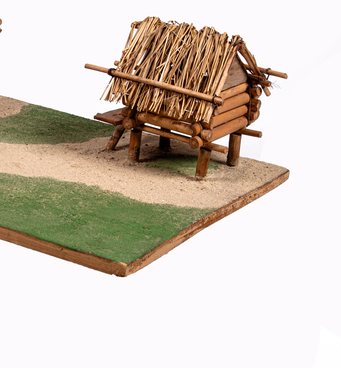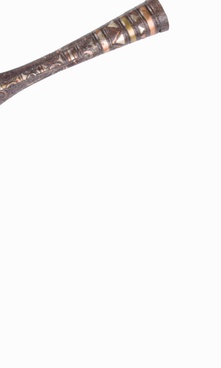The Evenki national costume has always delighted travelers with its brightness, simplicity and unique cut, which reflected religious and magical, ethnic and aesthetic ideas, as well as the high level of spiritual and material culture of the ethnic group.
All the researchers also noted that all the local Tungusic ethnic groups had similar clothing ensembles. They pointed out its composition: an open caftan, a bib on the neck, natazniki deerskin underpants, gaiters, and unty boots.
The costume on display was made by the Evenki craftswoman Lubov Umrikhina from the village of Nelkan, Ayano-Maysky District, Khabarovsk Krai. The costume consists of a headdress, caftan, bib and shoes. Lubov Umrikhina sewed it in 2010.
All elements of clothing feature the “loon’s foot” pattern. This sacred bird was believed to protect and ward off misfortunes. The caftan is of the East Siberian type — open, with straight unfastened panels and a straight hem. The back and hem edges are decorated with beadwork.
The bib has the shape of an elongated inverted regular pentagon. Lubov Umrikhina attached deerskin ties to its upper corners to fasten it around the neck, and sewed a short fringe of beads along the lower edge. She placed long deerskin straps along the center of the sides to fasten it on the waist.
The craftswoman embroidered the whole of the front side with beads. The pattern of embroidery is geometric: the craftswoman used stripes and lines, alternating beads of different colors, with rectangles in the center and at the bottom. Compositionally, the bib is divided into two parts by a wide band (belt), on which a chain of diamonds was embroidered.
The fork-shaped pattern in the upper part resembles a stylized image of a loon’s foot. The headdress has the shape of a bonnet. Its cut consists of three parts — a lengthwise one, which is supposed to cover the top and back of the head, and two side parts, which are designed to protect the ears and cheeks. The hat is covered with beadwork.
Lubov Umrikhina was born
in the village of Aim, Ayano-Maysky district, Khabarovsk Krai. She learned sewing,
cutting and dressing hides from her mother, the famous Evenki craftswoman
Tamara Dyachkovskaya, and embroidery — from her grandmother, Elena Karamzina.



